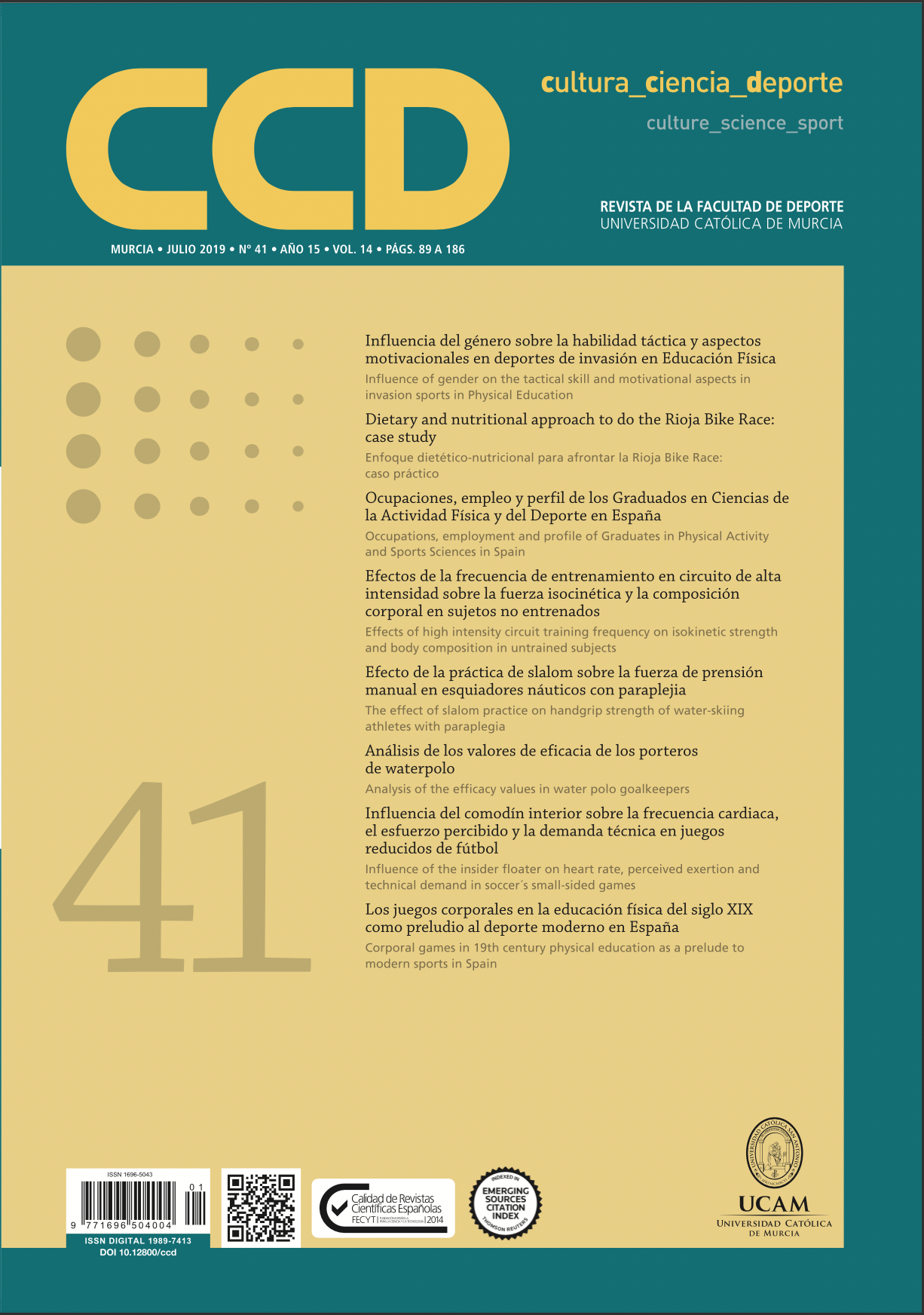Efectos de la frecuencia de entrenamiento en circuito de alta intensidad sobre la fuerza isocinética y la composición corporal en sujetos no entrenados. (Effects of high intensity circuit training frequency on isokinetic strength and body composition in untrained subjects).
DOI:
https://doi.org/10.12800/ccd.v14i41.1272Resumen
El objetivo de este estudio fue analizar los efectos que provoca la frecuencia de entrenamiento en circuito de alta intensidad sobre la fuerza isocinética y la composición corporal en sujetos no entrenados. Se llevó a cabo un estudio con un diseño cuasi experimental con pre y post test utilizando un dinamómetro isocinético y un densitómetro para realizar las mediciones. Un total de 39 participantes se dividieron atendiendo al nivel de actividad física, composición corporal y sexo en tres grupos de entrenamiento (GE) y un grupo control (GC), entrenando con una frecuencia de 1, 2 o 3 días semanales durante 8 semanas. En relación a la fuerza isocinética, aunque los sujetos pertenecientes a GE1, GE2 y GE3 consiguieron mejoras significativas (p ≤ 0,05) en todas las variables analizadas en extensión y flexión de rodilla, no se hallaron diferencias significativas al comparar entre grupos. En lo relativo a la composición corporal, solo se hallaron resultados tendentes a la significación en GE1 en la masa muscular con un valor de p= 0,06. En relación a GC, no se observaron diferencias estadísticamente significativas en ninguna de las variables sometidas a medición. El entrenamiento en circuito de alta intensidad propuesto consigue adaptaciones en la fuerza isocinética en la articulación de la rodilla al entrenar un día, dos días y tres días a la semana y ciertos aumentos en la masa muscular en sujetos no entrenados.
===
The main aim of the present study was to analyze the effects of high intensity circuit training on isokinetic strength and body composition in untrained subjects. A quasi experimental design with pre and post test using an isokinetic dynamometer and a densitometer to perform the measurement was carried out. A total of 39 participants were divided according to the level of physical activity, body composition and sex into three training groups (TG) and one control group (CG), training with a frequency of 1, 2 or 3 days a week for 8 weeks. Regarding the isokinetic strength, although the TG1, TG2 and TG3 subjects achieved significant improvements (p ≤ 0,05) in all the variables analyzed in extension and knee flexion, no significant differences were found when comparing among training groups. Regarding body composition, results were only found tending to the significance in TG1 in muscle mass variable with a value of p= 0,06. In relation to CG, no statistically significant differences were observed in any of the variables undergone measurement. The proposed high intensity circuit training achieves an improvement in isokinetic strength in the knee joint by training one day, two days and three days a week and certain increases in muscle mass in untrained subjects.The main aim of the present study was to analyze the effects of high intensity circuit training on isokinetic strength and body composition in untrained subjects. A quasi experimental design with pre and post test using an isokinetic dynamometer and a densitometer to perform the measurement was carried out. A total of 39 participants were divided according to the level of physical activity, body composition and sex into three training groups (TG) and one control group (CG), training with a frequency of 1, 2 or 3 days a week for 8 weeks. Regarding the isokinetic strength, although the TG1, TG2 and TG3 subjects achieved significant improvements (p ≤ 0,05) in all the variables analyzed in extension and knee flexion, no significant differences were found when comparing among training groups. Regarding body composition, results were only found tending to the significance in TG1 in muscle mass variable with a value of p= 0,06. In relation to CG, no statistically significant differences were observed in any of the variables undergone measurement. The proposed high intensity circuit training achieves an improvement in isokinetic strength in the knee joint by training one day, two days and three days a week and certain increases in muscle mass in untrained subjects.
Descargas
Publicado
Cómo citar
Número
Sección
Licencia
Los autores que publican en esta revista están de acuerdo con los siguientes términos:- Los autores conservan los derechos de autor y garantizan a la revista el derecho de ser la primera publicación del trabajo al igual que licenciado bajo una Creative Commons Attribution License que permite a otros compartir el trabajo con un reconocimiento de la autoría del trabajo y la publicación inicial en esta revista.













